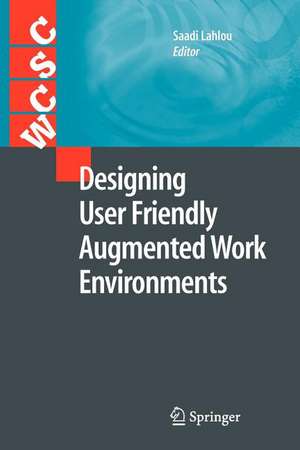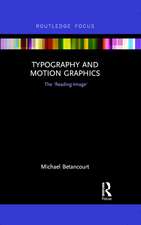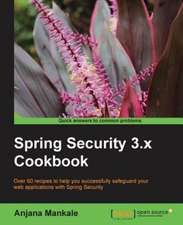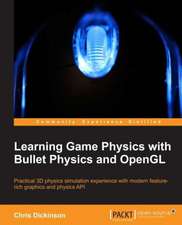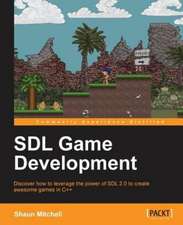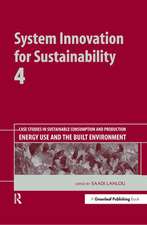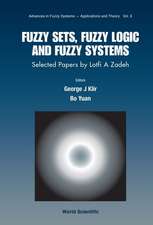Designing User Friendly Augmented Work Environments: Computer Supported Cooperative Work
Editat de Saadi Lahlouen Limba Engleză Paperback – 14 mar 2012
| Toate formatele și edițiile | Preț | Express |
|---|---|---|
| Paperback (1) | 988.98 lei 6-8 săpt. | |
| SPRINGER LONDON – 14 mar 2012 | 988.98 lei 6-8 săpt. | |
| Hardback (1) | 995.24 lei 6-8 săpt. | |
| SPRINGER LONDON – 13 oct 2009 | 995.24 lei 6-8 săpt. |
Din seria Computer Supported Cooperative Work
- 20%
 Preț: 1044.25 lei
Preț: 1044.25 lei - 20%
 Preț: 650.59 lei
Preț: 650.59 lei - 20%
 Preț: 647.61 lei
Preț: 647.61 lei - 20%
 Preț: 638.55 lei
Preț: 638.55 lei - 20%
 Preț: 334.53 lei
Preț: 334.53 lei - 20%
 Preț: 328.79 lei
Preț: 328.79 lei - 20%
 Preț: 334.71 lei
Preț: 334.71 lei - 20%
 Preț: 330.90 lei
Preț: 330.90 lei - 20%
 Preț: 328.79 lei
Preț: 328.79 lei - 20%
 Preț: 649.28 lei
Preț: 649.28 lei - 20%
 Preț: 643.50 lei
Preț: 643.50 lei - 20%
 Preț: 329.91 lei
Preț: 329.91 lei - 15%
 Preț: 642.83 lei
Preț: 642.83 lei - 20%
 Preț: 648.11 lei
Preț: 648.11 lei - 20%
 Preț: 996.40 lei
Preț: 996.40 lei - 20%
 Preț: 647.79 lei
Preț: 647.79 lei - 20%
 Preț: 413.81 lei
Preț: 413.81 lei - 20%
 Preț: 336.02 lei
Preț: 336.02 lei - 20%
 Preț: 346.10 lei
Preț: 346.10 lei - 20%
 Preț: 330.24 lei
Preț: 330.24 lei - 20%
 Preț: 982.36 lei
Preț: 982.36 lei - 20%
 Preț: 329.11 lei
Preț: 329.11 lei - 20%
 Preț: 987.32 lei
Preț: 987.32 lei - 20%
 Preț: 641.34 lei
Preț: 641.34 lei - 20%
 Preț: 648.26 lei
Preț: 648.26 lei - 20%
 Preț: 995.89 lei
Preț: 995.89 lei - 20%
 Preț: 643.63 lei
Preț: 643.63 lei - 20%
 Preț: 328.42 lei
Preț: 328.42 lei - 20%
 Preț: 988.81 lei
Preț: 988.81 lei - 20%
 Preț: 643.30 lei
Preț: 643.30 lei - 20%
 Preț: 987.17 lei
Preț: 987.17 lei - 20%
 Preț: 329.58 lei
Preț: 329.58 lei - 20%
 Preț: 309.58 lei
Preț: 309.58 lei - 20%
 Preț: 330.42 lei
Preț: 330.42 lei - 5%
 Preț: 365.82 lei
Preț: 365.82 lei - 20%
 Preț: 650.08 lei
Preț: 650.08 lei - 20%
 Preț: 334.38 lei
Preț: 334.38 lei - 20%
 Preț: 645.79 lei
Preț: 645.79 lei - 20%
 Preț: 650.40 lei
Preț: 650.40 lei - 20%
 Preț: 333.88 lei
Preț: 333.88 lei - 20%
 Preț: 1263.81 lei
Preț: 1263.81 lei - 20%
 Preț: 830.58 lei
Preț: 830.58 lei - 20%
 Preț: 704.70 lei
Preț: 704.70 lei
Preț: 988.98 lei
Preț vechi: 1236.23 lei
-20% Nou
Puncte Express: 1483
Preț estimativ în valută:
189.24€ • 198.11$ • 156.58£
189.24€ • 198.11$ • 156.58£
Carte tipărită la comandă
Livrare economică 05-19 aprilie
Preluare comenzi: 021 569.72.76
Specificații
ISBN-13: 9781447125150
ISBN-10: 1447125150
Pagini: 336
Ilustrații: XI, 321 p.
Dimensiuni: 155 x 235 x 18 mm
Greutate: 0.47 kg
Ediția:2010
Editura: SPRINGER LONDON
Colecția Springer
Seria Computer Supported Cooperative Work
Locul publicării:London, United Kingdom
ISBN-10: 1447125150
Pagini: 336
Ilustrații: XI, 321 p.
Dimensiuni: 155 x 235 x 18 mm
Greutate: 0.47 kg
Ediția:2010
Editura: SPRINGER LONDON
Colecția Springer
Seria Computer Supported Cooperative Work
Locul publicării:London, United Kingdom
Public țintă
Professional/practitionerCuprins
Augmented Environments and Design.- The Stanford Interactive Workspaces Project.- Towards a Global Concept of Collaborative Space.- Designing an Easy-to-use Executive Conference Room Control System.- Experimental Reality: Principles for the Design of Augmented Environments.- Co-design Approaches for Early Phases of Augmented Environments.- Ubiquitous Working Environments.- Psychological Methods for the Study of Augmented Environments.- Opportunities and Challenges for Augmented Environments: A Distributed Cognition Perspective.- The Aachen Media Space: Design Patterns for Augmented Work Environments.
Textul de pe ultima copertă
Augmented environments – where objects are empowered by underlying information technology, are now installed in an ever-growing number of offices, public spaces and homes. However designing them to be usable and user-friendly remains a challenge.
This book provides an overview and summary of the key research undertaken in augmented environments by some of the most prominent laboratories in the field worldwide (Stanford, Carnegie-Mellon, Fuji-Xerox Palo Alto, EDF R&D, Politecnico di Milano, Swedish Royal Institute of Technology, Russian Academy of Science, UC San Diego, University of Aachen). The book covers all relevant aspects of Augmented Environments from architecture to computer science and psychology. Most useful theories (activity theory, distributed cognition, cognitive attractors, perceived quality…) and design principles (COTS, semantic Rubicon, never-endingness…) as well as practical patterns for implementation are provided by the seminal authors themselves.
With this overview, readers can benefit from the experiences of key researchers in the field to construct robust, efficient and user-friendly augmented environments. All those working in the field of human-computer interaction will find this book an invaluable reference source.
This book provides an overview and summary of the key research undertaken in augmented environments by some of the most prominent laboratories in the field worldwide (Stanford, Carnegie-Mellon, Fuji-Xerox Palo Alto, EDF R&D, Politecnico di Milano, Swedish Royal Institute of Technology, Russian Academy of Science, UC San Diego, University of Aachen). The book covers all relevant aspects of Augmented Environments from architecture to computer science and psychology. Most useful theories (activity theory, distributed cognition, cognitive attractors, perceived quality…) and design principles (COTS, semantic Rubicon, never-endingness…) as well as practical patterns for implementation are provided by the seminal authors themselves.
With this overview, readers can benefit from the experiences of key researchers in the field to construct robust, efficient and user-friendly augmented environments. All those working in the field of human-computer interaction will find this book an invaluable reference source.
Caracteristici
Gathers, summarises and puts into perspective material from some of the most prominent teams who pioneered the domain of AE Authors approach is grounded in actual experience. They have designed and operated real augmented workspaces which are in daily use This is a growing market - good practice is not yet established, and building such augmented rooms is not routine, so such constructions will involve consultants and architects, and local academia, who will need food for thought This is still a research topic and academics as well as sponsor institutions are looking for legitimate scientific sources to refer to
